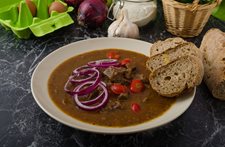
Michelin stars in the Czech Republic? Surely an oxymoron! Guess again. Prague has become one of the hottest food destinations in Europe thanks to innovative Czech and international chefs, who are introducing new twists to some old favorites, farm-to-table models, locavore values, and some unexpected foreign imports from the country’s newer citizens including its 83,000 Vietnamese who have brought their own foods and flavors to the Czech capital.
To find out more about this dynamic culinary revolution, I spoke to Jan and Zuzi, the foodie enthusiasts behind Prague’s leading culinary blog, A Taste of Prague. The couple have been charting the food revolution for several years, and keep their devoted readers informed about new restaurants and food venues in some of Prague’s leading restaurant districts such as the Karlin district or Dlouha street in the heart of the old city.
Jan and Zuzi have seen a dramatic change in the way Czechs regard their own traditional cuisine. Following the end of communism in the late eighties, Czechs veered towards more international food. “Food critics simply asserted that French and Italian was where it’s at, while Czech cuisine was inferior.” Eschewing heavier dishes such as schnitzel, goulash, and tripe soup, Czechs began to prefer lighter fare. However, five years ago this began to change with a new generation coming of age and revisiting pre-Communist traditional dishes for inspiration, a general culinary trend extant in many parts of Eastern Europe and the former Soviet Union. Restaurants such as La Degustation in Prague have led the way in serving up traditional dishes with modern twists.
“…We think it [suggests] that we may be regaining some of the pride we may have lost in the 40 years of decline under Communism,” say Jan and Zuzi. Czechs are also becoming more interested in the origin of their food, with nose-to-tail butchering on the rise at restaurants such as Čestr and Sansho. Jan and Zuzi put this locavore enthusiasm down to the baby boomers of the 1970. “[This is] the first affluent generation after the end of Communism, and now they have their own children and are not afraid to pay a premium for organic and nose-to-tail. The big supermarket chains are still ruled by the pan-European supplies of generic food bought in bulk, but many now turn on to local and seasonal produce because it is hip and tastes better.”
Beer has always been a big part of Czech culture, but now artisanal beers have taken their rightful place alongside the mass produced brands, and the Moravian wine industry is experiencing a heady revival. Jan and Zuzi explained: “We’re a cold-climate wine country, so nearly 70% of the wines are white. Whites are dry, fresh, crisp and fruity with high acidity, very clean tasting. The reds are lighter. Think pinot noir and its cousins. One of the biggest trends are now natural wines without any use of chemistry in the growing or processing of the grapes, often promoted by a new, young generation of winemakers that now seem to be replacing the legends.”
Alexander+Roberts pioneered travel to Eastern Europe for Americans, and feature Prague on many of our itineraries including our
Budapest, Krakow + Prague private journey.